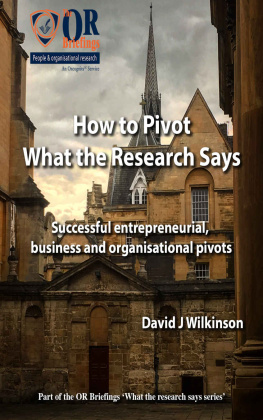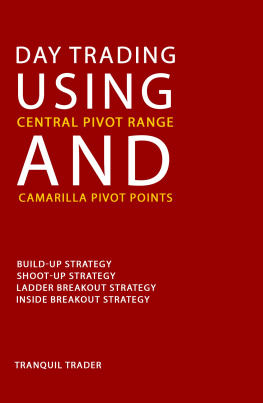
How to Pivot
What the Research Says
Successful entrepreneurial, business and organisational pivots
Part of the
OR Briefings What the research says series
By Dr. David J. Wilkinson
www.oxford-review.com
Keywords: business, pivot, entrepreneur , entrepreneurial, change, adaptation, creative adaptation
Special Report:
Successful Businesses Pivots:
What the research says
Published by Oxcognita LLC
Copyright 2020 Oxcognita LLC
All rights reserved. No part of this publication may be reproduced, distributed, or transmitted in any form or by any means, including photocopying, recording, or other electronic or mechanical methods, without the prior written permission of the publisher, except in the case of brief attributed quotations embodied in critical reviews and certain other noncommercial uses permitted by copyright law. For permission requests, write to the publisher, addressed Attention: Permissions Coordinator, at the address below.
Oxcognita Press : Oxcognita LLC, Nevis
www.Oxford-Review.com
Ordering & subscription information:
Quantity sales. Special discounts are available on quantity purchases by corporations, associations, and others. For details, contact the publisher at the address above.
Printed in the United Kingdom by our agents Oxford Review Enterprises Ltd.
Publishers Cataloging-in-Publication data
Editor: Wilkinson, David John.
The Oxford Review / David J. Wilkinson.
p. cm.
1. The main category of the book Business and Management Education & Learning. HF0000.A0 A00 2019
299.000 00dc22 2010999998 Title: How Businesses Pivot Successfully What the research says
Special Report:
How Businesses Pivot Successfully: What the research says
With thanks to Julia Main for her patience and proofreading magic her attention to research detail, double checking my take on the research and for the shear amount of reading I put her through. Thank you!
Contents
How businesses pivot - what the research actually says
A pivot, or pivoting, is a primary method for moving a business in a new direction. In effect, it is a strategic reorientation, which usually entails:
Repositioning the direction, aims and goals of the business or organisation.
Creating and testing a new direction which is fundamentally different from the original one.
Strategically realigning the business or organisation with current market forces and needs.
Reorganising structures, systems, production, procedures etc.
Probably one of the most notable and famous recent pivots was the creation of the Slack communication platform by entrepreneur Simon Butterfield, an enterprise which is today (2020) valued at approximately $5.1bn. Originally, Butterfield and his colleagues had been developing an online game called Game Never-ending, which flopped spectacularly. He then tried to develop another game called Glitch, which also failed. Along the way, in order to keep his global virtual team of developers connected and informed, he had developed a bespoke collaboration tool. Eventually, this was to become Slack in one of the higher-profile and more successful pivots ever.
The question is, what factors contribute to a successful pivot?
Essentially, a pivot is a creative revision , change or adaption based on feedback, usually from the market and, as a result, is an evolving, iterative and dynamic process of testing, probing and experimenting. Rarely, if ever, is a pivot a sudden change in direction based on certainty of the outcome or final direction.
Pivots are particularly important in times of rapid or even sudden change, for example, the 2007/8 financial crisis, the 2020 Covid-19 Pandemic, etc. During these times businesses need to adapt rapidly to the new world reality or die. However, it is not just during rapid or sudden upheaval or disruption that pivots become a useful survival strategy for businesses. For many smaller companies and start-ups the pivot is an essential tactic of finding ones way, working out what the customers want, need and are willing to pay for, and just of the business optimisation process.
A pivot can range from a sudden and unthought through, almost random, change in direction right through to a completely planned out strategy. The question is which type of pivot tends to work best and what are the elements which make the difference?
For these questions and more we turn to the research.
Clearly, a pivot for a one-person business is technically simpler and potentially quicker than a for multinational corporation employing thousands across the globe. However, the resources available to larger organisations are usually significantly greater.
The art of the pivot is considered to be a key aspect of entrepreneurship .
This special report looks at what the research says about creating a pivot.
Why focus on business models?
A business model represents and articulates a perceived business opportunity and how that opportunity is, or might be, exploited. As such, an organisations business model encapsulates, or sums up, the perceptions and assumptions of the business owners and leaders about the market and their place in it. How closely the business model reflects the market reality is a measure of the effectiveness of the organisation.
When shifts and changes occur, the current business model can rapidly get out of date resulting in declining customer base, relevance and profit. Seismic shifts through:
political
economic
scientific
technological
environmental
legal and
social
change can see a business moving from a place of healthy engagement in the market to one of irrelevance in a heartbeat, as has been shown in the 2020 Covid-19 pandemic.
Survival can require the business to rapidly shift its model.
Recent pivots
For example, the current pandemic has seen the following rapid pivots:
- An entertainments and stage builder in LA in the US tendered for and won contracts to help build temporary hospitals.
- New Balance, a shoe company, shifted production from shoes to face masks in the space of two days.
- Bauer, who make hockey and sports gear, shifted production to make surgical face shields in three days.
- Ford, 3M and GE collaborated to combine know how and technology to produce respirators.
- Brewers like Brewdog, Pernod and Bacardi moved into hand and industrial sanitiser production.
- 6 Bosley real estate agents moved their entire huge teams of staff into food and essential supply deliveries, as they had a national network and communication structure.
- A single steak house in St. Louis shifted to becoming a butchers shop and linked to a local car parts distribution service to do deliveries.
- Cafes and restaurants moving into ready meal production and linking to local shops and supermarkets to get to market.
- A local comedy club in Germany moved online and started doing improv and stand-up comedy courses. They had no online materials beforehand.
- Subway outlets started to sell ingredients separately, turning their shops into mini-supermarkets in some states in the US.
- Online organisations, coaches and consultants going free, or at reduced rates knowing that helping people now will pay off afterwards, as people become embedded with their products and services.
- A dog trainer in New York who has moved onto lessons on Instagram and has then moved prospects on to Skype and Zoom for 1-1 lessons and advice.






